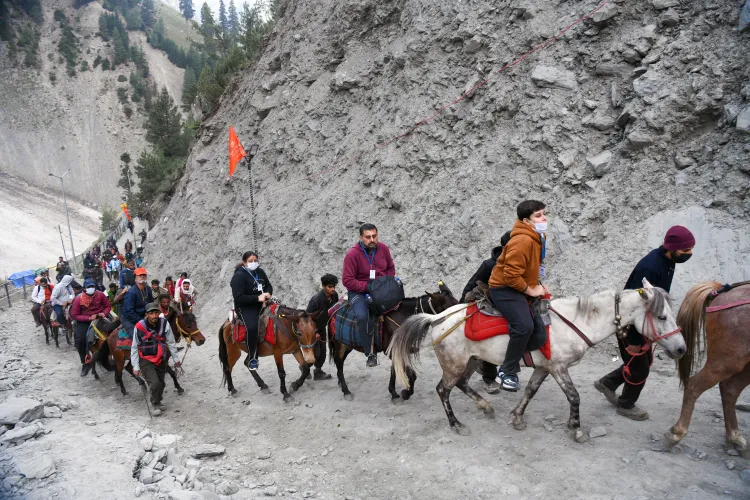How Many Yatris Have Completed the Amarnath Yatra in Just 10 Days?

Synopsis
Key Takeaways
- 1.82 lakh Yatris have performed the Yatra in 10 days.
- Security measures include Operation SHIVA 2025.
- The Yatra concludes on August 9.
- Two routes available: Pahalgam and Baltal.
- The shrine features a unique ice stalagmite structure.
Srinagar, July 13 (NationPress) In the past 10 days, more than 1.82 lakh Yatris have undertaken the ongoing Amarnath Yatra. Another group of 7,049 pilgrims departed for Kashmir from Jammu this Sunday.
Officials reported that since the Yatra commenced on July 3, over 1.82 lakh pilgrims have had the opportunity to experience ‘darshan’ at the sacred cave shrine.
"We anticipate that this number will exceed two lakh today as the Yatra continues to progress smoothly and without incident. An additional group of 7,049 Yatris departed from Bhagwati Nagar Yatri Niwas in two escorted convoys. The first convoy, comprising 138 vehicles and carrying 2,891 Yatris, left at 3:30 a.m. for the Baltal base camp, while the second convoy, featuring 148 vehicles with 4,158 Yatris, departed at 4:20 a.m. for the Nunwan (Pahalgam) base camp," officials mentioned.
The Bhumi Pujan for the ‘Chhari Mubarak’ (Lord Shiva’s Holy Mace) took place at Pahalgam on Thursday. The Chhari Mubarak was escorted to Pahalgam by a group of sadhus led by the custodian, Mahant Swami Deependra Giri, from its location at the Dashnami Akhara Building in Srinagar.
Upon arrival in Pahalgam, the Chhari Mubarak was transported to the Gauri Shankar temple for the Bhumi Pujan ceremony. The Chhari Mubarak is expected to arrive at the holy cave shrine on August 9, officially concluding the Yatra.
This year’s Amarnath Yatra has seen comprehensive multi-tier security arrangements, particularly following the tragic attack on April 22, where 26 civilians were killed by Pakistan-backed terrorists in the Baisaran meadow of Pahalgam.
To strengthen security, an additional 180 companies of CAPFs have been deployed alongside the existing forces of the Army, BSF, CRPF, SSB, and local police.
The Army has initiated 'Operation SHIVA 2025', deploying over 8,500 troops and advanced surveillance and combat technologies. This large-scale operation, coordinated with civil administration and CAPFs, aims to create a multi-layered security framework along both the Baltal and Pahalgam routes.
As part of this extensive security deployment, a specialized counter-UAS (Unmanned Aerial System) network with over 50 C-UAS and EW (Electronic Warfare) systems has been established to mitigate drone threats.
“Live surveillance utilizing UAVs (drones) and PTZ camera feeds is continuously monitoring Yatra convoys and the holy cave. Engineer task forces have been activated for infrastructure projects such as bridge building, track expansion, and landslide management. The operation also includes over 150 doctors and paramedics, two Advanced Dressing Stations, nine Medical Aid Posts, a 100-bed hospital, and 26 oxygen booths backed by 2 lakh litres of oxygen. Additionally, Signal companies, EME technical detachments, and Bomb Detection and Disposal Squads have been deployed,” stated the Army.
All transit camps along the routes to the two base camps and the entire pathway from Bhagwati Nagar Yatri Niwas in Jammu to the cave shrine are secured by security forces.
The Yatra, which began on July 3, will run for 38 days and conclude on August 9, coinciding with Shravan Purnima and Raksha Bandhan.
Yatris may reach the holy cave shrine, located 3,888 metres above sea level in the Kashmir Himalayas, using either the traditional Pahalgam route or the shorter Baltal route.
Those opting for the Pahalgam route travel through Chandanwari, Sheshnag, and Panchtarni, covering a distance of 46 km on foot, which typically takes four days to complete. Alternatively, those taking the shorter Baltal route must trek 14 km to the cave shrine and return to the base camp the same day after completing the Yatra.
No helicopter services are available for Yatris this year due to security concerns.
The cave shrine is home to an ice stalagmite structure that changes size with the lunar phases. Devotees believe that this ice stalagmite symbolizes the mystical powers of Lord Shiva. The Amarnath Yatra is one of the most sacred religious pilgrimages for Hindu devotees, as legend has it that Lord Shiva revealed the secrets of eternal life and immortality to Mata Parvati within this cave.









